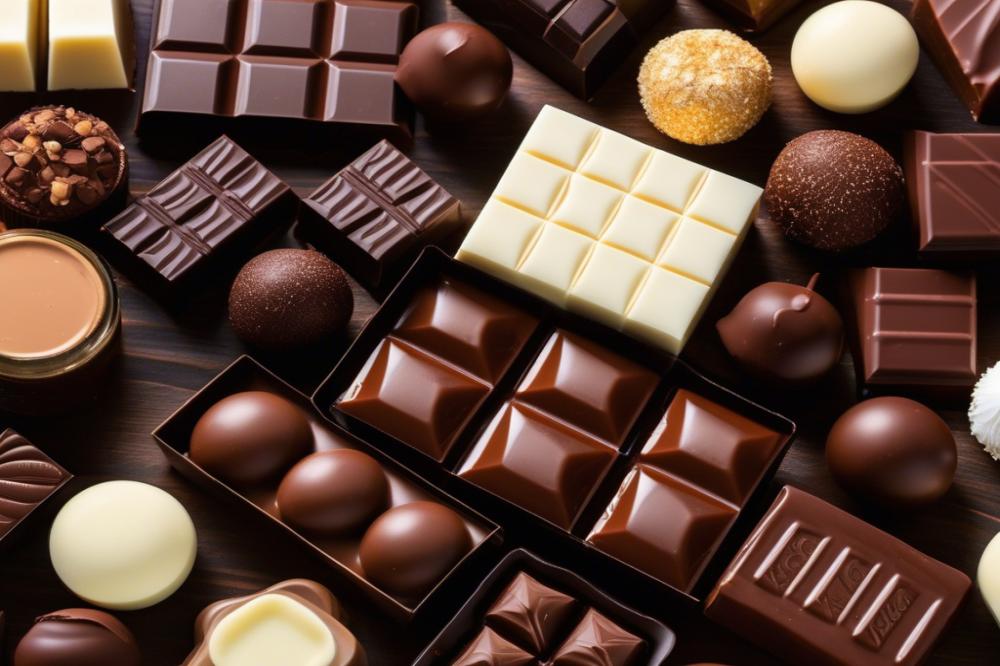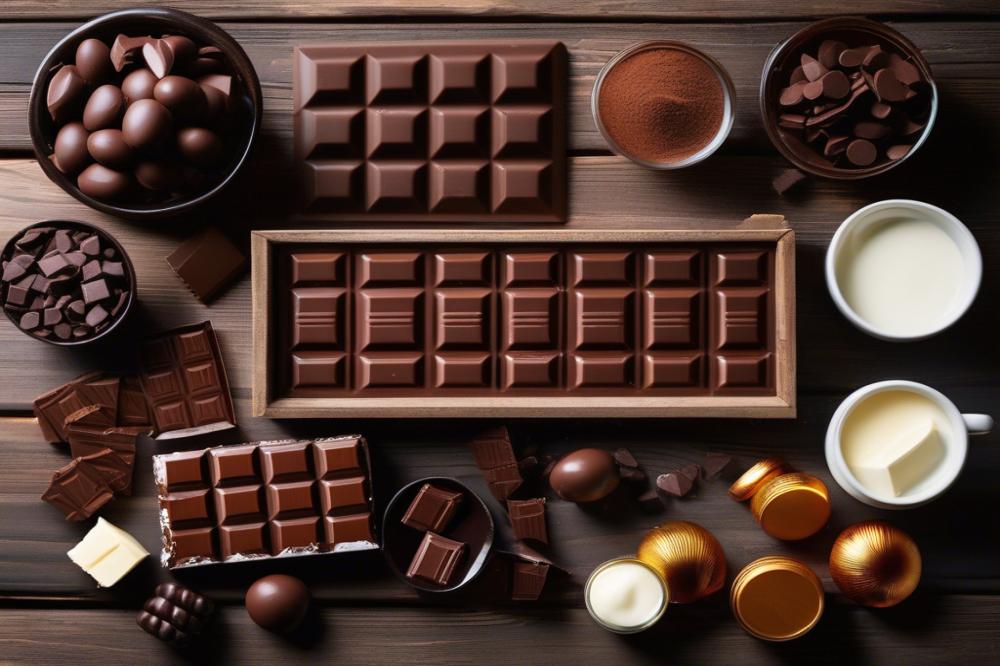Introduction
Chocolate lovers around the world recognize the joy of indulging in their favorite treat. However, many may not realize that proper chocolate preservation is crucial for maintaining its delightful experience. Storing chocolate in the right conditions can significantly impact its overall flavor and quality. When the storage setting is suboptimal, chocolates risk becoming stale or losing their rich taste.
Think about it. Dark chocolate, with its intense flavors, needs different care compared to milk or white chocolate, which are sweeter and creamier. Temperature plays a vital role in this process. The ideal temperature for chocolate is typically between 65°F to 70°F (18°C to 21°C). This range helps to keep it fresh and prevents unwanted changes. Additionally, humidity control cannot be overlooked. Excess moisture can lead to a sugary bloom that alters the texture and taste.
This article aims to guide readers through the best practices of chocolate storage. By understanding how to avoid common pitfalls, enthusiasts can extend the shelf life of their chocolates without compromising on their beloved flavors. Whether you’re a casual snack enthusiast or a passionate connoisseur, learning about the nuances of chocolate preservation ensures an enjoyable experience each time. Let’s dive into tips for maintaining chocolate quality, focusing on the importance of airtight containers, temperature regulation, and more.
chocolate storage Best Practices

Understanding Chocolate Preservation Principles
Chocolate preservation is about keeping its flavor and texture intact. When chocolate is stored incorrectly, it can develop unpleasant tastes or become too soft. Knowing how chocolate reacts to different environments is key.
Ideal Temperature Ranges for Different Types of Chocolate
Dark chocolate storage often requires a slightly different approach compared to milk or white chocolate. The best temperature range for chocolate generally falls between 65°F to 70°F (18°C to 21°C). Keeping dark chocolate slightly cooler helps maintain its strong flavor. Milk chocolate and white varieties do better in similar temperatures but can be more sensitive to heat. Avoid exposure to direct sunlight; it can quickly affect the taste.
Importance of Humidity Control for Flavor Retention
Humidity plays a crucial role in flavor retention. High humidity can cause chocolate to sweat, leading to a change in texture. This can also create a sticky surface that attracts dust and odors. Ideally, chocolate should be stored in a dry environment. Maintaining humidity levels between 45% and 55% is ideal.
Using Airtight Containers to Maintain Quality
Storing chocolate in airtight containers is one of the best practices to keep it fresh. Doing so prevents air and moisture from entering, which can compromise chocolate quality. Glass jars or resealable plastic bags work well for this purpose. Always label containers with the date. This simple step can help track freshness and keep your chocolate tasting delicious for longer.
Storage Guidelines for Different Types of Chocolate

Dark Chocolate Storage Recommendations
Dark chocolate tends to have a longer shelf life than its milkier counterparts. The ideal temperature for storing it is between 60°F and 70°F (15°C and 21°C). Keep it in a cool, dry place away from direct sunlight. Using airtight containers is essential to prevent exposure to air, which can affect flavor retention. These containers also guard against unwanted aromas from nearby foods. Proper humidity control is crucial; high humidity can lead to sugar bloom, which creates a white powdery appearance but doesn’t affect taste.
Milk Chocolate and White Chocolate Considerations
Milk chocolate and white chocolate have milk solids, making them more susceptible to spoilage. They should ideally be stored at similar temperatures, around 65°F to 70°F (18°C to 21°C). Storing these types in airtight containers is vital. This protects them from moisture and other contaminants. Humidity can be a bigger enemy for milk and white chocolates. Chocolate preservation practices are particularly important here as both of these varieties can absorb moisture, affecting their texture and flavor.
Variations in Storage Needs Based on Chocolate Composition
Different chocolates require attention to their unique compositions. Dark chocolate’s high cocoa content grants it resilience, while milk chocolate’s milk solids make it more delicate. White chocolate, often lacking cocoa solids, is the most sensitive to temperature variations. The quality of chocolate can suffer in environments that are too humid or too hot. Always label containers with the storage date to keep track of freshness. Adjust storage practices based on chocolate variety to maintain the best flavor and overall experience. Explore the best practices based on the unique characteristics of each type for optimal enjoyment.
Transporting Chocolate: Tips for Maintaining Quality
Transporting chocolate requires careful consideration to prevent spoilage. Chocolate preservation is vital to keeping its delightful taste and texture intact. When moving chocolate, a few best practices can make a significant difference in maintaining quality.
Temperature Control During Transport
Maintaining the ideal temperature is crucial. Chocolate is sensitive to heat, especially milk chocolate and white chocolate. Ideally, it should be kept at temperatures between 60°F and 70°F. Anything above this range can cause melting or bloom, impacting its appearance and flavor retention.
Using insulated containers can help regulate temperature during transport. Consider employing ice packs or gel packs to keep the chocolate cool. Avoid exposing chocolate to direct sunlight or heat sources. A shaded spot in the transport vehicle will provide some protection, but active measures are generally more effective.
Preventing Damage During Shipping or Handling
Taking care to prevent damage is just as important as temperature control. Chocolate can be fragile, and rough handling may cause it to break. To protect delicate pieces, pack chocolate in airtight containers or sturdy boxes. This will help guard against moisture, which can lead to texture issues.
Humidity control is another essential factor. High humidity can lead to sugar bloom on the surface of chocolate. This occurs when moisture compounds form, leaving a white powdery residue. Keeping chocolate in a dry environment minimizes this risk, which is crucial during transit.
When shipping chocolate, label the package with “Fragile” to alert handlers. This small detail can encourage more cautious treatment. Avoid stacking heavy items on top of chocolate packages. Proper packing practices go a long way in ensuring the integrity of the product.
Lastly, consider the type of chocolate. Dark chocolate is typically more resilient than its milder counterparts, but it still requires care. All chocolate types deserve attention during transport to maintain their delightful qualities. Attention to detail here can lead to a truly enjoyable experience upon arrival.
Common Mistakes in Chocolate Storage
Chocolate lovers often make simple mistakes that can ruin their favorite treat. One common error is exposing chocolate to light. Sunlight or bright indoor lights can alter its taste. Instead, store chocolate in a dark place to protect its quality.
Another frequent oversight involves scent exposure. Chocolate has a remarkable ability to absorb odors from its environment. Storing it alongside strong-smelling foods can compromise flavor retention. An airtight container is essential to keep those unwanted smells at bay.
Humidity control plays a vital role as well. Chocolate thrives in dry conditions. High humidity can lead to a white, powdery coating known as bloom. This doesn’t make the chocolate unsafe, but it can alter its texture and taste.
Different types of chocolate require unique methods. Dark chocolate storage is often less complicated compared to milk chocolate or white chocolate. Dark chocolate can be stored at room temperature due to its lower milk content. On the other hand, milk and white varieties are more sensitive and benefit from cooler environments.
Recognizing signs of spoilage is crucial for chocolate preservation. If you notice an off smell or strange texture, it’s time to toss that bar. Chocolate can last for long periods, but not indefinitely. Always check for changes that may indicate it’s past its prime.
Maintaining ideal temperature is also important. Storing chocolate in a refrigerator can lead to condensation when taken out. This moisture can cause bloom, ruining the visual appeal. Instead, a cool, dry pantry is often the best choice.
By understanding these common mistakes, chocolate enthusiasts can enjoy their treats for longer. Following these tips helps preserve flavor and texture, ensuring the utmost satisfaction with every bite.
Final Thoughts on Chocolate Storage
Recapping the best practices for storing chocolate can help everyone enjoy it at its best. First, keeping chocolate in a cool, dark place is crucial. Avoid sunlight and humidity, as both can ruin its flavor and texture. The ideal temperature is around 65 to 70 degrees Fahrenheit. This control helps to prevent the chocolate from melting or becoming too hard.
Use airtight containers to fend off unwanted odors and moisture. Wrapping each piece in foil can also aid in chocolate preservation. Remember to separate different types or flavors. Mixing them might lead to cross-contamination of tastes. Nobody wants a surprise when biting into dark chocolate, expecting a rich experience only to find a hint of mint.
Proper storage is not merely about prolonging shelf life. It’s also about maintaining the exquisite taste and texture that chocolate lovers adore. Freshly stored chocolate retains its unique qualities, ensuring every bite is delightful. Those who take the time to implement these tips will find their chocolate experiences to be much richer.
Everyone should feel encouraged to incorporate these practices into their habits. By doing so, you not only extend the lifespan of your chocolate but also enhance its flavors. Experience chocolate as it was meant to be savored, full of richness and joy. Happy indulging!



